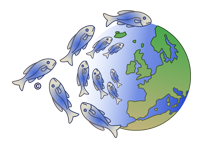

Diazona violacea s a colonial ascidian forming massive colonies of up to 40 cm in diameter and 20 cm in height. Young colonies are rather ball-shaped, whereas older ones are slightly flattened. The zooids are joined in a common gelatinous cushion-shaped base. The branchial parts of the zooids (the upper parts) are distinct and emerge of 2 cm from the base. The test is more or less translucent, white or yellowish. A vertical line draws the endostyle of each zooid; the atrial and oral siphons are underlined by a white margin and six white spots ornate the upper part of the pharynx. Diazona zooids resemble clavelina ones but their bases are different: a thick basal mass for Diazona versus a thin basal stolon for Clavelina. At the end of summer, after reproduction time, zooids atrophy and there's only the basal mass left. In spring-time, the colony buds again from this base.
Diazona violacea lives attached to rocks or stones covered by sand, in strong current-swept areas between 15 and 200 meters deep in the Atlantic Ocean, the English Channel and the Mediterranean Sea.
Source : World Register of Marine Species
Biota (Superdomain)
Animalia (Kingdom)
Chordata (Phylum)
Tunicata (Subphylum)
Ascidiacea (Class)
Aplousobranchia (Order)
Diazonidae (Family)
Diazona (Genus)
Diazona violacea (Species)
Zooid : individual, single animal.
Test : or tunic: thick layer secreted by the mantel containing cellulose and protecting the animal.
Oral siphon : opening by which water is drawn in the ascidian.
Atrial siphon : opening through which water is expelled.
Text : Anne Bay-Nouailhat © 2007 - 2026.
Photos : ©
Javier Santiago, Wilfried Bay-Nouailhat. PPublished with their kind permission.
Websites and reference works : Consult bibliography
Image satellite: © Esri, DigitalGlobe, GeoEye, Earthstar Geographics, CNES/Airbus DS, USDA, USGS, AeroGRID, IGN, and the GIS User Community.
Données de distribution : Diazona violacea Savigny, 1816 in GBIF Secretariat (2019). GBIF Backbone Taxonomy. Checklist dataset https://doi.org/10.15468/39omei accessed via GBIF.org on 2026-01-07.
Source : World Register of Marine Species
Biota (Superdomain)
Animalia (Kingdom)
Chordata (Phylum)
Tunicata (Subphylum)
Ascidiacea (Class)
Aplousobranchia (Order)
Diazonidae (Family)
Diazona (Genus)
Diazona violacea (Species)
Zooid : individual, single animal.
Test : or tunic: thick layer secreted by the mantel containing cellulose and protecting the animal.
Oral siphon : opening by which water is drawn in the ascidian.
Atrial siphon : opening through which water is expelled.
Text : Anne Bay-Nouailhat © 2007 - 2026.
Photos : ©
Javier Santiago, Wilfried Bay-Nouailhat. PPublished with their kind permission.
Websites and reference works : Consult bibliography
Bay-Nouailhat A., January 2007, Description of Diazona violacea, [On line] https://european-marine-life.org/32/diazona-violacea.php, consulted on 2026 January 07.
Author

Chargée d’études en environnement marin
Plongeuse professionnelle - Naturaliste
© Mer et littoral 2004-2026 - All rights reserved
The texts and images on this website are not free of rights and cannot be copied and/or used without the agreement of their respective authors.